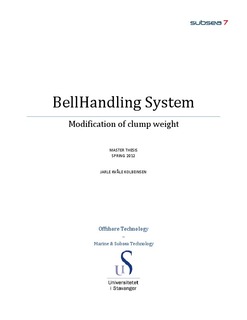| dc.contributor.author | Kolbeinsen, Jarle | |
| dc.date.accessioned | 2012-10-19T12:42:43Z | |
| dc.date.available | 2012-10-19T12:42:43Z | |
| dc.date.issued | 2012 | |
| dc.identifier.uri | http://hdl.handle.net/11250/182980 | |
| dc.description | Master's thesis in Offshore technology | no_NO |
| dc.description.abstract | The dive support vessel Seven Havila is a new and top modern vessel with the most advanced dive system in the world. In 2011 she was awarded with the prestigious title “Support Vessel of the Year”. But modern design has their downsides, as a design often needs several versions before all the “child diseases” are gone.
Onboard Seven Havila a problem was encountered in the bell handling system. They are having a problem with the port and starboard bell clump weight deployment angle. The problem is that when the clump weight is deployed before the bell, the clump weight gets a tilt up to 60 degrees. Over a period of time this will cause the guide wires and bell frame bushes to wear and will increase the amount of maintenance.
The objective with this master thesis is to find possible solutions to straighten up the deployment/ recovery angle so they are sitting in the horizontal position as the design specification instructed.
As a research method, experimental trials with a clump weight model have been conducted. Studies of other clump weight designs were also an important part of the research. Simple calculations have been done to give an indication of the effect of the different solutions.
Several of the solutions will have a positive effect, but none of the solutions, except the use of two winches instead of one, will remove the tilt problem completely. The use of ballast weight to lower the CoG gave good results in the test trials, but because we are limited with the amount of weight we are allowed to add, we cannot expect the same effect. The use of support arms to act as a momentum counter to the tilt force gave the best results during the trials.
The final recommendation is to either:
1. Expand the diameter on the split bush and to add the allowable weight of 250 kg at the bottom of the clump weight. A lower COG will counter the tilt angle while the expanded diameter will allow for more free space and reduce the amount of friction caused by the bend.
2. Install supports arms and where the remaining weight is placed at the bottom of the clump weight.
The first option will require less work and is more cost effective than the second option, but the last option will give more tilt reduction. | no_NO |
| dc.language.iso | eng | no_NO |
| dc.publisher | University of Stavanger, Norway | no_NO |
| dc.relation.ispartofseries | Masteroppgave/UIS-TN-IKM/2012; | |
| dc.subject | offshore teknologi | no_NO |
| dc.subject | undervannsteknologi | no_NO |
| dc.title | Modification of clump weigth | no_NO |
| dc.type | Master thesis | no_NO |
| dc.subject.nsi | VDP::Technology: 500::Marine technology: 580::Offshore technology: 581 | no_NO |
